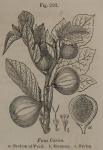 Sex. Syst. Polygamia, Trioecia, Linn.—Polygamia, Dioecia, Willd.—Dioecia, Triandria, Pers.
Sex. Syst. Polygamia, Trioecia, Linn.—Polygamia, Dioecia, Willd.—Dioecia, Triandria, Pers.
(Fructus praeparatus, L.—Fici: the dried fruit, E. D.)
History.—In the Old Testament we are informed that Hczekiah (who lived 600 years before Christ) used figs as a topical application to a boil. [Isaiah, xxiviii. 81.] The figtree is the συκή of Dioscorides, [Lib. i. cap. 183.] the Ficus of Pliny. [Hist. Nat. lib. xxiii. cap. 63.]
Botany. Gen. Char.—Monoecious. Flowers numerous, pedicellated, inclosed within a fleshy receptacle, which is umbilicated, and nearly closed at the apex, hollow within. Calyx 3—5-lobed: lobes acuminate. Male-flowers near the umbilicus. Stamens 3—5. Ovary free (Desf.); semi-adnate (Gaertn.). Style 1. Stigmas 2. Drupe or utricle 1-seeded, sunk into the pulpy receptacle. Coat of the nut fragile, crustaceous (Bot. Gall.).
Sp. Char.—Leaves cordate, palmate; scabrous above, pubescent beneath (Bot. Gall.).—A small tree. Flowers in June. Receptacle green. At the base of each receptacle are two or three bracteal scales.
Hab.—Native of Asia and South of Europe.
Description.—Figs (fici seu caricae) constitute that kind of collective fruit called, by Mirbel, a syconus. They consist of fleshy, hollow, pyriform receptacles, within which are numerous, small, seed-like bodies (achenia, Lindley; utricles, Auctor). In the unripe state they contain an acrid and bitter juice, but which, when they are ripe, is replaced by sugar. Ripe figs are dried in the sun or in ovens, and are afterwards packed in drums and baskets, in which they are imported. As met with in the shops, they are more or less compressed, are covered with a whitish, saccharine efflorescence, have a brownish or yellowish colour, and are somewhat translucent. They have a peculiar and agreeable odour, and contain a sweet, viscid pulp, in which are the achenia. Turkey or Smyrna figs are the largest, most juicy, and sweetest; hence they are sometimes termed fat figs (caricae pingues): they are distinguished into pulled and flat. Of 20,406 cwts. of figs, imported in 1830, no less than 18,801 came from Turkey (Parliam. Return).
Composition.—Bley [Pharm. Central-Blatt für 1831, S. 27] analyzed Smyrna figs, and obtained the following results: Sugar of figs 62.5, fatty matter 0.9, extractive with chloride of calcium 0.4, gum with phosphoric acid 5.2, woody fibre and seeds [achenia] 15.0, and water 16.0=100.0.
Physiological Effects.—Figs are nutritive, emollient, demulcent, and laxative. In the fresh state they are both agreeable and wholesome: when dried, as we receive them, they readily disorder the stomach and bowels, and occasion flatulence, griping, and mild diarrheoa.
Uses.—In those countries where they are plentiful, figs are used as food. Here they are chiefly employed as a dessert. Internally they are given in the form of demulcent decoctions (as the Decoctum Hordei compositum, L. D.) in pulmonary and nephritic affections. As laxatives they are sometimes taken with the food to relieve habitual constipation, and enter into the composition of Confectio Sennae, L. (Electuarium Sennae, E.). Roasted or boiled, and split open, they are employed as suppurative cataplasms in gum-boil, &c.

